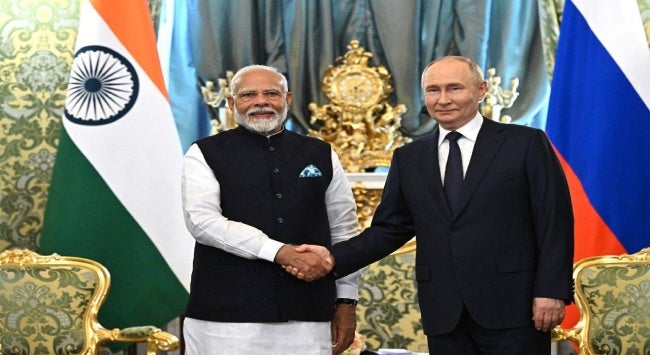Summary
Indian Prime Minister Narendra Modi’s recent visit to Russia was an opportunity for India to signal that Russia is a key partner and the two counties have a longstanding relationship that transcends crises and challenges.
Why did Indian Prime Minister Narendra Modi make Moscow the first foreign stop in his third term? The visit was important for three reasons.
First, it signals Russia’s importance to India, a relationship that has remained mostly solid since 1947. This visit was the first between Modi and Vladimir Putin since the Ukraine war and Modi’s first visit to Moscow since 2015. Modi did not intend for the visit to be a marker that India was taking Russia’s side or endorsing Russia’s war in Ukraine but to demonstrate India regards Russia as an important diplomatic partner in an increasingly fractious world. It was also to show that Russia matters for the diplomatic support it has given to India over the decades, as an energy and oil provider as India’s growth accelerates since the pandemic, and as a key defence supplier. Ukraine aside, the visit showed that this remains a normal and reliable inter-state relationship for India with issues that require dialogue.
Second, the visit signifies India’s importance as a state with a foreign policy that balances relationships and partnerships with the West and Russia. Modi’s bilateral summit with Putin, which unfolded alongside the North Atlantic Treaty Organization’s 75th anniversary summit in Washington, underscored the sharp divide between the West and the Global South on dealing with Russia as the war unfolds in Ukraine. In a nutshell, the West favours Russia’s isolation while much of the Global South prefers neutrality. That India views itself as a champion of the Global South exemplifies the chasm between the West and the Global South concerning Ukraine. Geopolitically, India also matters to Russia. India’s purchase of Russian oil and the Indian market helps send the message that options exist for Putin to continue his war. India also helps Russia hedge against China as it relies more on Beijing further for strategic solace.
Third, the visit allowed India and Modi to sensitise Moscow to its concerns regarding China and the close China-Russia partnership that erodes India’s security. Relations between India and China have been stuck at a low point since the 2020 border dispute and there is apprehension in New Delhi that Beijing and Moscow getting much closer could be problematic for India. India needs Russia to counterbalance China. There is ostensibly some hope in New Delhi that Moscow can help moderate Chinese behaviour across the contested border.
In terms of Ukraine, India would like for the conflict to end soon but is not placed to affect that outcome as it looks like Russia is not seeking peace now. At the recent Ukraine peace summit in Switzerland, India was among seven countries that did not endorse the final communique asserting that both sides have to agree to push for peace. India has largely focused on mitigating itself from the economic effects of the war which have been substantial while intermittently raising these concerns with Moscow as it expands its war efforts.
What transpired out of the visit? The visit and summit largely focused on bilateral issues like defence, security, trade and connectivity. In terms of trade, there is a large trade imbalance between both countries with India importing nearly US$60 billion (S$81 billion) while only exporting only US$4 billion (S$5.4 billion)to Russia. In fact, bilateral trade surged to US$65 billion (S$87.7 billion) in 2024 as oil imports rose from Russia to India. Beyond trade, there is hope that Russia somehow evades the United States’ (US) sanctions to reinvest the Rupees it has accumulated selling oil to India in India itself to drive up inward investment. Sixty per cent of India’s military equipment and systems remain of Russian origin and this supply line is imperilled with Russia using arms for its war in Ukraine. India will have likely asked for more predictability here.
Modi’s Moscow visit was meant to sustain the relationship, maintain and reinforce existing links and continue defence and energy cooperation. Ukraine has tested and transformed the relationship and continues to cast a shadow. Security, oil and defence – all the core aspects driving bilateral ties – have become much more salient to not only Russia’s war effort in Ukraine but also India’s growth, its ability to defend itself and its relationships with Europe, the US and the larger world.
The India-Russia relationship is and has been narrowly organized – oil and defence. There have been discussions to broaden the relationship away from defence and toward energy, raw materials and technology, given India’s rapid growth and the demands posed by that. As India increases defence imports from the US, France, Israel and South Korea, Russia could transition as a provider of niche defence technologies that other countries appear unwilling to provide India. Yet, that transition has not happened and this visit did not set the balling towards that. The summit’s final statement indicates that the India-Russia relationship remains stuck in the past. Yet, in a world mired in war and intense major power rivalry, Russia provides India with an option and lifeline to advance its core interests.
. . . . .
Dr Karthik Nachiappan is a Research Fellow at the Institute of South Asian Studies (ISAS), an autonomous research institute at the National University of Singapore. He can be contacted at isaskn@nus.edu.sg. The author bears full responsibility for the facts cited and opinions expressed in this paper.
Pic Credit: Media posts by Narendra Modi (@narendramodi) / X (twitter.com)
-
 More From :
More From :
-
 Tags :
Tags :
-
 Download PDF
Download PDF



